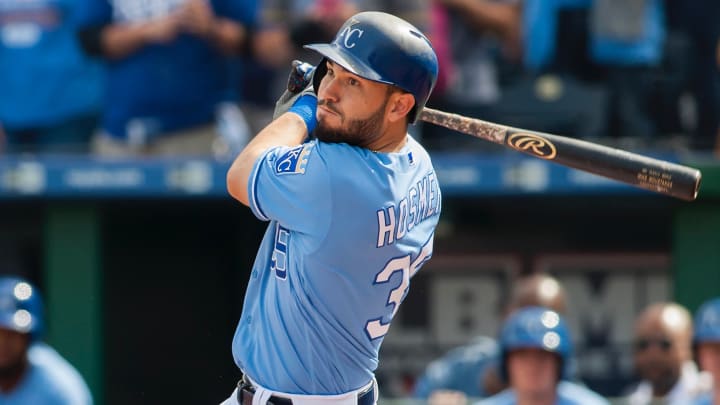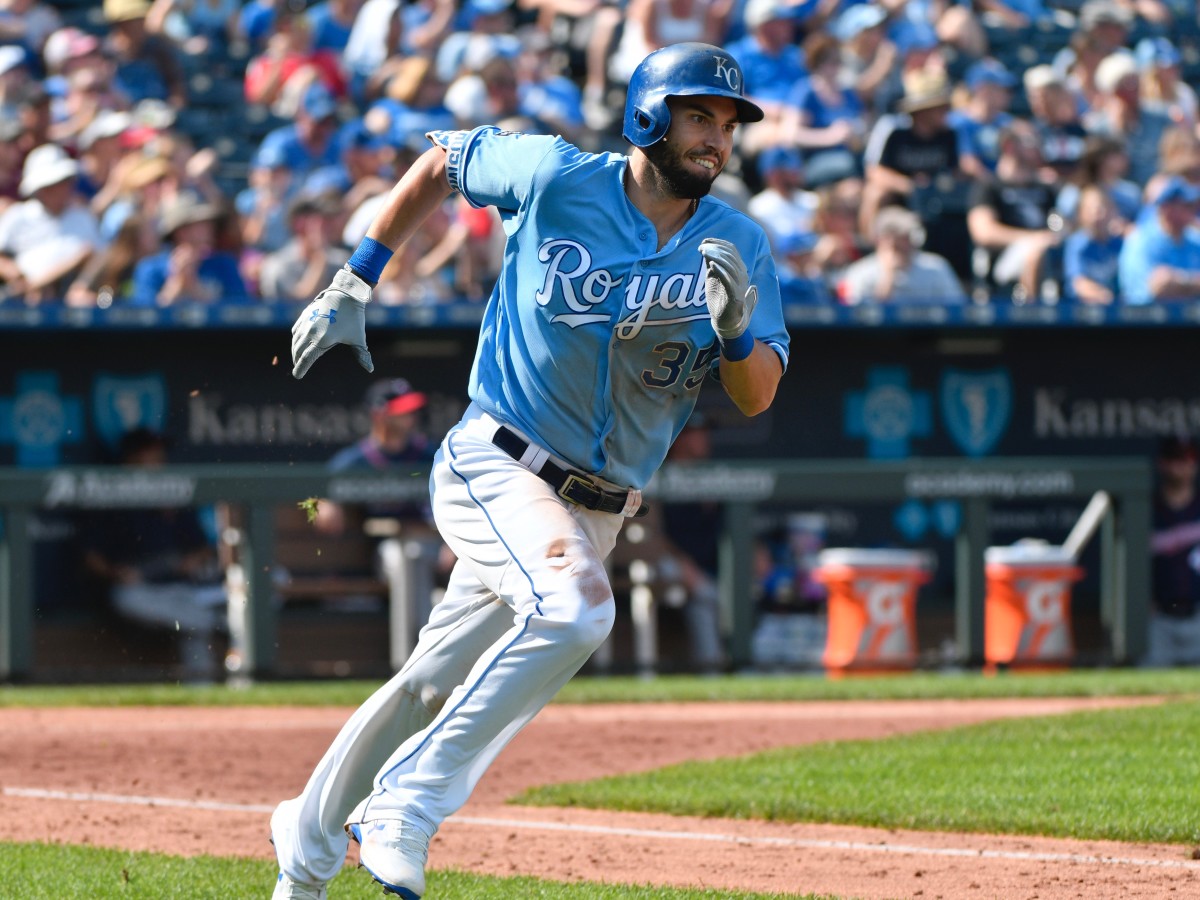What Is Eric Hosmer Really Worth?

The calendar says 2018, and the MLB offseason is now two months old, but by and large, the marquee free agents remain unsigned—16 of the top 20 on The Reiter 50, with Wade Davis (no. 6), Carlos Santana (no. 9) and Brandon Morrow (no. 18) the exceptions. To date, no free agent, inside or outside the top 50, has inked a contract of longer than three years, which isn't to say that longer offers haven't been made. Via USA Today's Bob Nightengale, both the Royals and the Padres are said to have offered Eric Hosmer seven-year deals, worth $147 million and $140 million, respectively.
While far short of the $200 million contract agent Scott Boras reportedly has in mind for his client, that's not exactly chump change. According to an October report from the Kansas City Star's Sam Mellinger, Boras, in one of his infamous three-ring binders, even tried to quantify Hosmer's intangibles: “Boras breaks it down into categories: clubhouse effect, media skills, community involvement, performance under psychological pressure, etc., to come up with a, well, a tangible measurement of something impossible to measure tangibly.”
Somebody will need to put a hefty price tag on such intangibles to get Hosmer anywhere close $140 million, let alone $200 million, because it's difficult to justify making a nine-figure commitment to him based upon performance alone. All of which makes the 28-year-old first baseman a player worth putting though my What's He Really Worth system, a model that incorporates a player's last three years of performance, a projection of his future value, and estimates of the market cost for a win, the rate of inflation and an age-related decline as a means of analyzing free agent deals.
The overall number three pick of the 2008 draft, Hosmer is well-known thanks to his prominent role in helping the Royals to the 2014 and '15 World Series, with a victory over the Mets in the latter. He hit a sizzling .351/.439/.526 during the team’s improbable 2014 run, and while he scuffled the following October, his 14th inning sacrifice fly ended Game 1 of the World Series, he drove in the winning run the next night, and scored the tying run in the ninth inning of the decisive Game 5 thanks to some daring baserunning. But even with that exposure—which must be the “prestige value” that Boras is getting at—he's made just one All-Star team in his seven major league seasons, and in fact has been most notable for his inconsistency and his modest power.
What Every AL Team Should Do in This Painfully Slow Offseason
Amid record-setting seasons for home runs around the majors, Hosmer he has bopped 25 homers in each of the past two seasons while driving in a total of 198 runs, but in general, he has lacked the power profile that comes with playing an offense-first position. Prior to 2016, he had never hit at least 20 homers, he's still never slugged .500 or better, and his career slugging percentage is just .439. While it's true that the Royals' Kauffman Stadium is one of the league's most homer-suppressing parks, Hosmer's career splits—.282/.344/.440 with 60 career homers at home, .285/.341/.437 with 67 homers on the road—are nearly identical. Thanks to a career unintentional walk rate of just 7.4%, his on-base percentages are nothing to write home about either; though he set a career high with a .385 mark in 2017, he's only been above .340 two other times.
As for that inconsistency, Hosmer has yet to string two good years together. Using park-adjusted numbers, in even-numbered years, he’s posted an OPS+ of 102 or lower (81 in 2012, 99 in '14, 102 in '16), a rate of production that's unacceptable for a full-time first baseman. He's been better in odd-numbered years, with marks of 118 in 2011 and '13, 122 in '15, and a career high 132 last year, but even that mark was merely tied for ninth among the 23 batting title qualifiers who spent at least 50% of their time at first base. The eighth-ranked player by OPS+, Yonder Alonso, signed a two-year, $16 million deal with the Indians.
On the other side of the ball, Hosmer has won four Gold Gloves, but the defensive metrics don't support the notion that he's an elite fielder by any stretch. He's 22 runs below average for his career according to Defensive Runs Saved, and 29 below average via Ultimate Zone Rating. Most of the red ink via both measures is from his first two seasons, but in his award-winning years (2013–15 plus '17), he's merely at -1 DRS and +3 UZR. Some, including Boras, Royals manager Ned Yost and unnamed talent evaluators, believe that the metrics are inaccurate in his case—Boras even called them "a hoax.” Given that the Hosmer-era Royals haven't been particularly strong at run prevention save for those two pennant-winning seasons, and that their primary defensive strength has been outfielders Alex Gordon, Lorenzo Cain and Jarrod Dyson, it's doubtful that Hosmer is being unduly harmed by such measures.
What's more, there's a limit to the impact a first baseman can have defensively—as opposed to a shortstop, for example—in that the best ones are generally around 10 runs above average per year. The top DRS for a first baseman from 2015–17 combined belongs to Paul Goldschmidt (+32) while the top UZR is from Brandon Belt (+21). For comparison, Andrelton Simons, the majors’ top shortstop, is at +75 DRS and +48 UZR in that same span, while the top third basemen are Nolan Arenado (+58 DRS) and Adrian Beltre (+32 UZR).

Between those ups and downs on offense and defense, Hosmer has never been worth more than about four wins in a single season. His 2017 season set career highs via both the Baseball-Reference and FanGraphs versions of WAR (4.0 and 4.1, respectively). His 2014 and '16 seasons were worth a combined 7.1 (B-Ref) or 6.6 WAR (FanGraphs). Since I prefer Baseball Reference’s formula, and since it holds Hosmer in much higher esteem overall (14.1 career WAR vs. 9.9), I'll stick with that measure here.
To estimate Hosmer's value going forward, the WHRW model uses Tom Tango's Marcel the Monkey forecasting system ("the most basic forecasting system you can have, that uses as little intelligence as possible") to establish a baseline based upon a 6/3/1 weighting of WAR; that is, six times his 2017 WAR plus three times his 2016 WAR plus his 2015 WAR, divided by 10. Tango's model also includes regression and an aging curve, specifically, a 20% regression in the first year (0.8 times that weighted WAR) and then a baseline loss of 0.4 WAR per year after, with both figures adjusted for age, adding (or subtracting) 0.1 WAR for each year under (or over) 30 years old.
While I have generally used fairly conservative estimates for dollars per win in the past (most recently $6.85 million for 2016), I'll start this exercise with a more aggressive estimate of $9 million for 2017 based upon Ben Markham's study of 101 free agent deals from last winter at Viva El Birdos; I'm also bearing in mind the steeper $10.5 million for 2017 based up on the work of Matt Swartz at FanGraphs, and I'll use the latter's 5.9% estimate for annual inflation instead of the 5.4% I had previously been using. Using those parameters, here's a first-stab at a seven-year projection for Hosmer (all dollar figures are in millions):
Year | Age | WAR | Market $/W | Value |
|---|---|---|---|---|
2018 | 28 | 2.6 | $9.53 | $25.2 |
2019 | 29 | 2.3 | $10.09 | $23.7 |
2020 | 30 | 1.9 | $10.69 | $20.8 |
2021 | 31 | 1.4 | $11.32 | $16.4 |
2022 | 32 | 0.8 | $11.99 | $10.2 |
2023 | 33 | 0.1 | $12.69 | $1.9 |
2024 | 34 | -0.7 | $13.44 | -$8.8 |
|
| 8.7 |
| $96.3 |
Forget $200 million, that forecast doesn't even project to be worth $100 million over seven years! The estimate jumps to $112.4 using Swartz's $10.5 million per win figure, but even that is still $28–35 million shy of the offers Hosmer has reportedly received. That’s a whole lot of prestige value... or perhaps pixie dust.
Back to the defense, let's suppose that the metrics are particularly screwing Hosmer to the tune of 10 runs per year, and that he’s actually more valuable. I'll add a full 1.0 WAR to each of the 2015–17 WARs that go into his 2018 projection—a huge and incredibly generous assumption for any player, particularly one whose -12 DRS from 2015–17 actually ranks 26th out of 29 first basemen with at least 1,500 innings in that span; instead, I'm effectively assuming he's the majors' fifth-best at the position (+18 DRS).
Year | Age | WAR | Market $/W | Value |
|---|---|---|---|---|
2018 | 28 | 3.4 | $9.53 | $32.9 |
2019 | 29 | 3.1 | $10.09 | $31.8 |
2020 | 30 | 2.7 | $10.69 | $29.4 |
2021 | 31 | 2.2 | $11.32 | $25.4 |
2022 | 32 | 1.6 | $11.99 | $19.8 |
2023 | 33 | 0.9 | $12.69 | $12.0 |
2024 | 34 | 0.1 | $13.44 | $2.0 |
|
| 14.3 |
| $139.2 |
What do you know? That figure is much more in the ballpark of the reported offers; the estimate jumps to $162 million using Swartz's $10.5 million per win. Working backwards, to get him into the $200 million range via the latter estimate—keeping the aging curve and other parameters in place, and ending up with a total of 18.3 WAR over the seven years—would require an assumption that he's been worth another seven runs per year beyond my generous 10-run bonus. Either that or MLB is about to experience enormous rates of inflation that throw the game’s entire financial structure out of whack. Color me skeptical.
Boras, whose job it is to get his client the best deal possible, has cited Hosmer's intangibles as major assets. But while he may be a great clubhouse guy who has experience in playing for a championship team, it's difficult to believe that any player can add that much in value beyond his actual production at the plate, on the bases and in the field. As it is, even if he winds up signing with the Royals, Padres or a suitor to be named later at a price in line with what's been reported, his chances of living up to such a contract appear slim.
